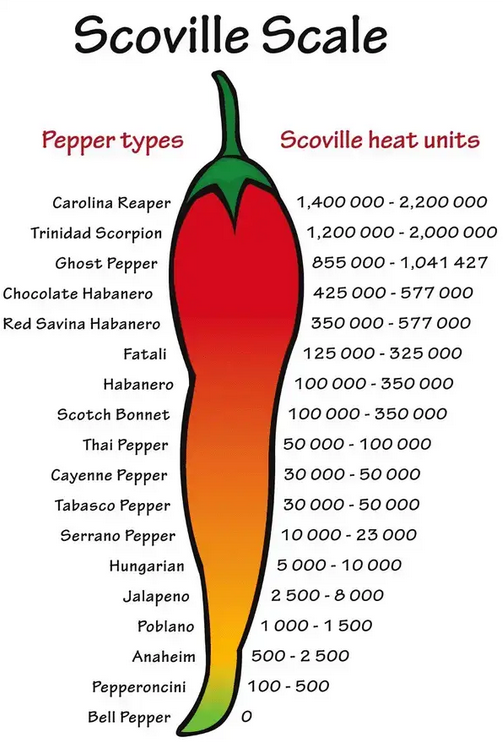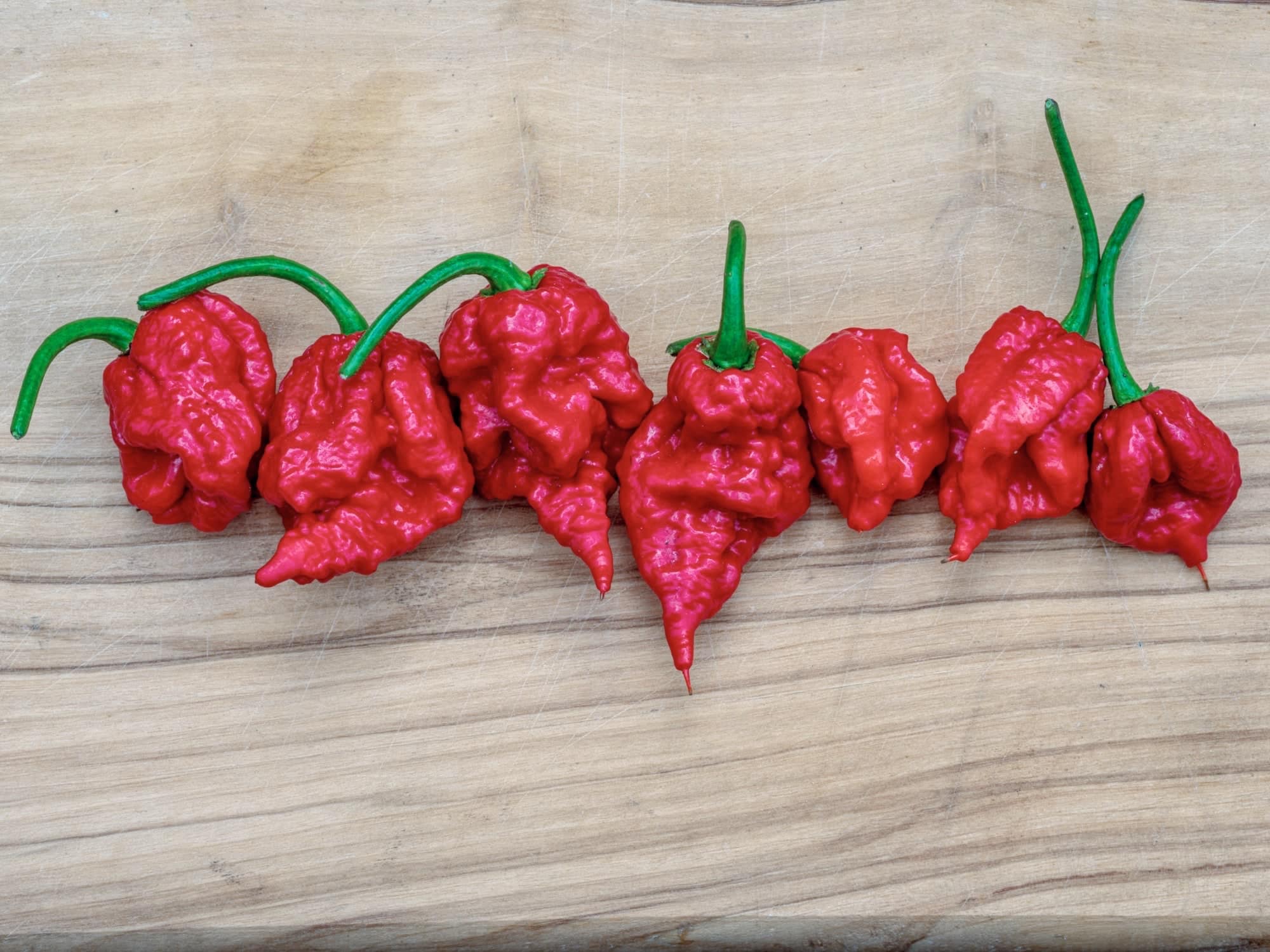In culinary adventures, the quest for flavors that tantalize the taste buds often leads us to spicy foods. While some prefer a milder touch of heat, others seek the fiery blaze found only in the world’s spiciest peppers and dishes.
The culinary world is replete with diverse flavors and sensations, and among the most intense is the burning sensation derived from spicy foods, primarily chili peppers. But how does one measure this spiciness? The answer lies in the Scoville Scale.
The Scoville Scale comes to the rescue to navigate this spicy landscape, offering a standardized measurement of the heat intensity in various peppers and foods. This article delves deep into the Scoville Scale, exploring its history, methodology, significance, and impact on the culinary world.
What is a Scoville Scale?
The Scoville Scale, invented by Wilbur Scoville in 1912, quantifies a pepper’s heat level based on capsaicin content. It measures spiciness in Scoville Heat Units (SHU), determined by diluting extracted capsaicinoids until their heat becomes undetectable to trained tasters. Higher SHUs indicate more heat.
The Scoville Scale was devised by an American pharmacist named Wilbur Scoville in 1912. Its initial purpose was to produce a consistent heat level in medicinal creams containing capsaicin, a compound extracted from chili peppers. Over the years, however, the Scoville Scale has found a more widespread application: ranking the spiciness of various peppers and spicy foods.
- Invented by Wilbur Scoville in 1912.
- Quantifies pepper’s heat based on capsaicin levels.
- Method: Extract capsaicinoids and dilute them with sugar water until they are undetectable by trained testers.
- More dilutions = higher heat index, measured in Scoville Heat Units (SHU).
- Example: Jalapenos range from 2,000 to 8,000 SHUs.
- The scale spans 0 SHUs (bell peppers) to 3.2 million SHUs (Pepper X).
- Factors influencing heat: temperature, soil type, and location.
The Scoville Scale is a measurement system designed to quantify the heat or spiciness of chili peppers and other spicy foods. Named after its creator, American pharmacist Wilbur Scoville, who developed the scale in 1912, it was initially called the “Scoville Organoleptic Test.” This ingenious system was born out of the need for a standardized way to communicate the heat level in peppers, as the perceived spiciness can vary significantly from person to person.

Methodology of Scoville Scale Measurement
The Scoville Scale quantifies the heat of peppers based on the presence of capsaicin, a compound responsible for the sensation of spiciness. The test involves diluting a pepper extract in sugar water until the heat is no longer detectable by a panel of tasters. The dilution ratio determines the heat level – the higher the ratio, the hotter the pepper.
Scoville Scale Measurement Procedure:
- Extraction: Remove capsaicinoids from the pepper.
- Dilution: Mix the extracted capsaicinoids with a sugar-water solution.
- Taste Testing: Have trained tasters sample the diluted solution.
- Determination: Continue diluting until the heat is undetectable to the tasters.
- Scoville Heat Units (SHU): The number of dilutions required determines the SHU value; more dilutions signify a higher heat level.
In its original form, the Scoville Organoleptic Test relied on human testers to determine the heat intensity. Peppers were dissolved in alcohol and then mixed with sugar water in various dilutions until the heat was no longer noticeable. The point at which the heat became undetectable determined the Scoville Heat Units (SHU) for that pepper.
Modern Methods: High-Performance Liquid Chromatography
Subjectivity and inconsistencies in the original method led to the development of more objective scientific techniques. The most widely accepted of these is High-Performance Liquid Chromatography (HPLC). This method separates and quantifies the amount of capsaicinoids in a pepper sample. The results from HPLC can then be converted into SHU, offering a more consistent and reproducible measurement.
Peppers on the Scoville Scale
- Bell Pepper: 0 SHU (contains no capsaicin)
- Jalapeño: 2,500 – 8,000 SHU
- Habanero: 100,000 – 350,000 SHU
- Carolina Reaper: Over 1.6 million SHU, with peaks at 2.2 million SHU
The list of peppers and their respective SHUs is extensive, with new contenders frequently vying for the world’s hottest pepper title.
Carolina Reaper hot chili pepper
The Carolina Reaper is a hot chili pepper known for its extreme heat. When discussing its place on the Scoville Scale and its taste:

- Scoville Heat Units (SHU): The Carolina Reaper holds an average SHU of over 1.6 million, with some individual peppers recorded at over 2.2 million SHU. This makes it one of the hottest peppers in the world.
- Taste: Before the intense heat kicks in, many people detect a sweet, fruity flavor akin to a sweet bell pepper or a tomato. This sweetness is then rapidly overtaken by an aggressive, fiery burn.
- Heat Sensation: When eaten, the heat from a Carolina Reaper can cause severe burning sensations that last for a long time. It begins as a wave and then intensifies, often reaching its peak several minutes after consumption.
- Physical Reactions: Due to its extreme spiciness, consuming the Carolina Reaper can lead to reactions such as sweating, tears, runny nose, and, in some cases, nausea or digestive discomfort.
Modern Adaptations and Technology
While the Scoville Organoleptic Test was a breakthrough in its time, it had limitations. Variability in human taste perception and the subjectivity of the testers could lead to inconsistent results. As a result, modern technology has played a pivotal role in refining the measurement process.
Today, high-performance liquid chromatography (HPLC) is used to measure capsaicin content directly. This method offers a more accurate and reproducible way to quantify the heat in peppers. The results are then converted to SHU values to maintain compatibility with the traditional Scoville Scale.
Significance in the Culinary World
The Scoville Scale has profound implications in the culinary world. Peppers vary dramatically in their heat levels, and the Scoville Scale helps chefs, home cooks, and food manufacturers create recipes with consistent spiciness. This allows individuals to gauge their tolerance for heat and make informed choices when selecting ingredients for their dishes.
Furthermore, the Scoville Scale has driven innovation in the cultivation of chili peppers. As the demand for spicier varieties has grown, breeders have developed hybrid peppers specifically engineered to reach higher heat levels. The competition to create the world’s spiciest pepper has captured the imagination of enthusiasts and further pushed the boundaries of what is considered “hot.”
Impact on Global Culture
Beyond cuisine, the Scoville Scale has infiltrated popular culture and become a measure of daring and bravado. Eating incredibly spicy foods and even participating in spicy food challenges have become viral, with individuals attempting to conquer peppers that register at astonishingly high SHU values.
Moreover, the Scoville Scale has facilitated international trade by providing a standardized reference for chili pepper heat. As spicy foods have become more globally accessible, this scale assists in communicating the level of heat to individuals from various cultural backgrounds.
Conclusion
The Scoville Scale has evolved from its pharmaceutical origins to become a cornerstone in the culinary world. It provides a standard by which the heat of peppers and spicy foods can be compared, celebrating the diversity and intensity of natural flavors. As chili enthusiasts continue their quest for hotter peppers and scientists refine measurement techniques, the Scoville Scale remains a pivotal tool in understanding and appreciating the world of spicy foods.
- How Many Tablespoons is One Clove of Garlic? - June 26, 2024
- How to Measure 3/4 Cup When You Don’t Have the Right Measuring Cup? - June 6, 2024
- How Much Does Cooked Pasta Weight Compare To Dry? - April 30, 2024
